Physical Address
304 North Cardinal St.
Dorchester Center, MA 02124
Choose transducer geometry and entry site to visualize the needle as a specular reflector.
Orient transducer to maximize tendon echogenicity (anisotropy).
Injected corticosteroid/anesthetic suspension often displays a contrast effect, which can help localize injected mixture.
Patients with diabetes should be cautioned that they may develop a transient hyperglycemia that may last up to 5 days following therapeutic injection.
Most small joints and superficial tendon sheaths of hand and foot can be injected using a short-axis approach.
Shoulder and hip joints can be injected using long-axis approach.
Ganglion and paralabral cyst fluid can be very viscous or gelatinous and may require a large-bore needle.
Choose needle trajectory to avoid neurovascular structures.
Intratendinous injections of platelet-rich plasma (PRP) should be performed in combination with intratendinous fenestration to promote bleeding and initiate an inflammatory response. The patient should avoid nonsteroidal antiinflammatory drugs (NSAIDs) for 1 week before and 2 weeks after the procedure.
Use of coaxial technique can be of value in performing ablative therapy and core biopsies to minimize extralesional soft tissue damage.
The real-time nature of ultrasound makes it ideally suited to provide guidance for a variety of musculoskeletal interventional procedures. Continuous observation of needle position ensures proper placement and allows continuous monitoring of the distribution of injected and aspirated material. The adverse effects of improper needle placement during corticosteroid administration are well documented. Likewise, decompression of fluid-filled lesions and fragmentation of calcific deposits may be performed.
The current generation of high-frequency transducers for sonography of small parts allows excellent depiction of soft tissue detail and articular surfaces, particularly in the hand, wrist, foot, and ankle. This allows needle placement in nonfluid-distended structures, such as a nondistended joint, tendon sheath, or bursa. The injected agent also produces a contrast effect, which can improve delineation of surrounding structures (e.g., labral morphology) and provide additional information regarding the agent's distribution. Ultrasound guidance has broad appeal because it does not involve ionizing radiation; this feature is particularly advantageous in the pediatric population and during pregnancy.
Ultrasound-guided injections in the musculoskeletal system include injection of joints, tendon sheaths, bursae, and ganglion cysts. The chapter emphasizes the most common injections performed at my institution, an orthopedic and rheumatology specialty hospital. The most common clinical indication for ultrasound-guided injections generally relates to pain that does not respond to other conservative measures, regardless of the anatomic site. The pain may result from a chronic repetitive injury in the work environment, a sports-related injury, or an underlying inflammatory disorder, such as rheumatoid arthritis.
Diagnostic and subsequent interventional examinations are often performed using either linear or curved, phased array transducers, based on depth and local geometry. Needle selection is based on specific anatomic conditions (i.e., depth and size of region of interest). We use a freehand technique in which the basic principle is to ensure needle visualization as a specular reflector. This relies on orienting the needle so that it is perpendicular (or nearly so) to the insonating beam ( Fig. 25.1 ). The needle then becomes a specular reflector, often having a strong ring-down artifact. Although needle guides are available and may be of value, a freehand technique allows greater flexibility in adjusting needle position during a procedure. Furthermore, needle visualization can be enhanced by injecting a small amount of anesthetic and observing the corresponding moving echoes in either gray-scale or color flow sonographic imaging.
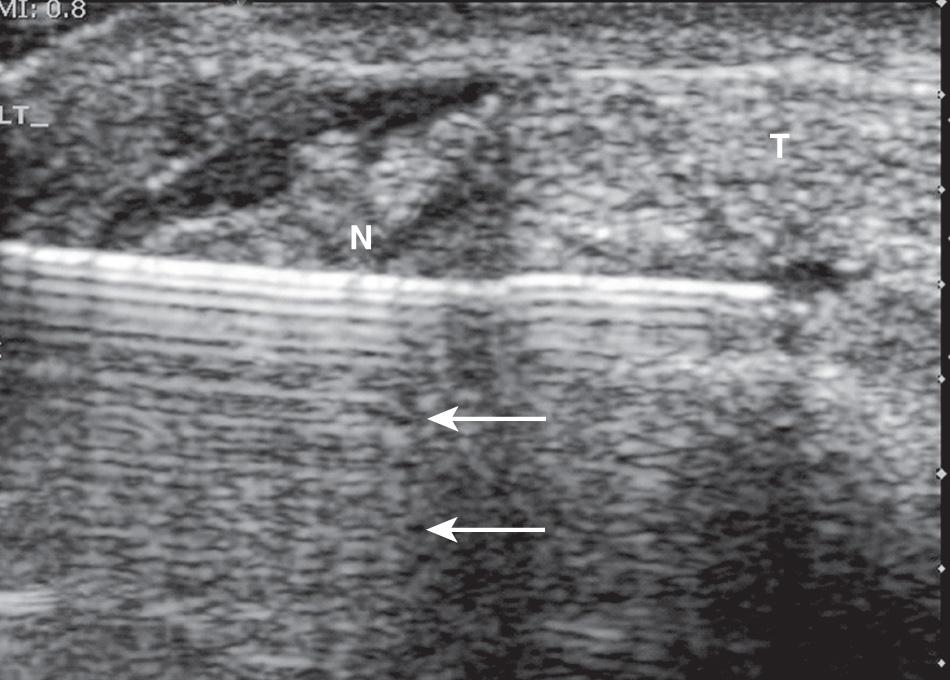
Patient positioning should be assessed first to ensure comfort and optimal visualization of the anatomy. It is important to keep in mind that tendons display inherent anisotropy; they will look hypoechoic if the transducer footprint is not parallel to the tendon. Therefore the transducer must be oriented to maximize tendon echogenicity to avoid false interpretation of the tendon as being complex fluid or synovium. An offset may be required at the skin entry point of the needle relative to the transducer to allow for the appropriate needle orientation. Deep structures, such as tendons about the hip, are often better imaged using a curved linear or sector transducer, operating at center frequencies of about 3.5 to 7.5 MHz. Superficial, linearly oriented structures, such as in the wrist or ankle, are best approached using a linear array transducer with higher center frequencies (>10 MHz). Transducers with a small footprint (“hockey stick”) are particularly well suited to superficial injections. These factors should be assessed before skin preparation.
The immiscible nature of the steroid anesthetic mixture may likewise produce temporary contrast effect ( Fig. 25.2 , Video 25.1 ). In vitro experiments suggest that this property is caused by alterations in acoustic impedance by the scattering material, formed by the suspension of steroid in an aqueous background; this results in an increase in echo intensity of about 20 dB. This contrast effect has the advantage of increasing the conspicuity of the delivered agent during real time, enabling the operator to better define the distribution of delivered agent during ultrasound-guided therapy.
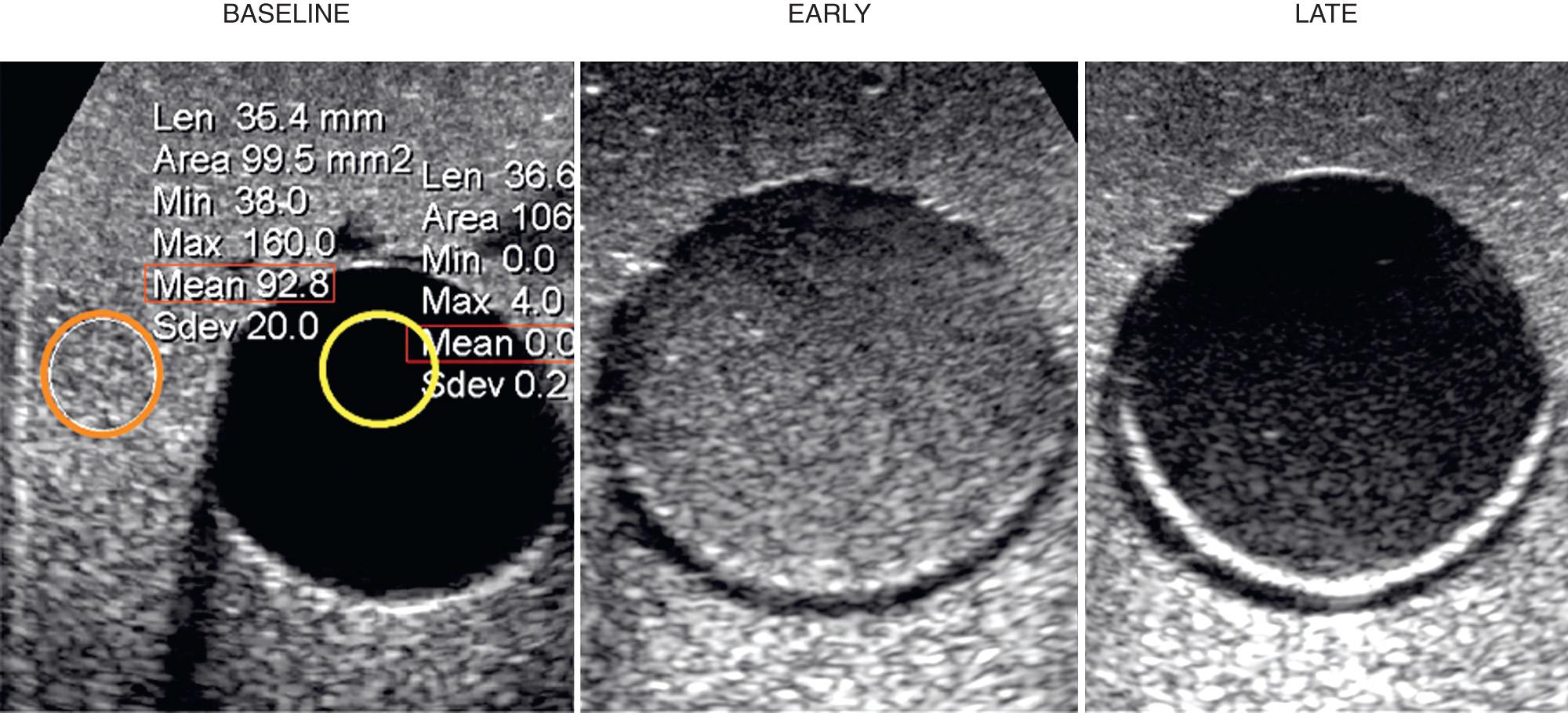
We use a sterile technique; the area in question is cleaned with iodine-based solution and draped with a sterile drape. The transducer is cleaned with iodine-based or alcohol-based solutions and surrounded by a sterile drape. A drape is also placed over portions of the ultrasound unit. A sonographer or radiologist positions the transducer; a radiologist positions the needle and performs the procedure. We use 1% lidocaine and bupivacaine (0.25%-0.75%) for local anesthesia. Once the needle is in position, the procedure is undertaken while imaging in real time. Depending on anatomic location, a 1.5-inch or spinal needle with stylet is used to administer the anesthetic-corticosteroid mixture, generally consisting of local long-acting anesthetic and one of the standard injectable corticosteroid derivatives (e.g., triamcinolone).
Two approaches to performing injections are long axis and short axis, which relate needle orientation to the structure being injected. The long-axis approach refers to needle placement in the plane parallel to the structure of interest ( Fig. 25.3 ). For example, longitudinal imaging of the hip to display a hip effusion might be used as the plane to direct the needle for ultrasound-guided aspiration. Alternatively, the short-axis approach refers to needle entry in the plane perpendicular to the long axis of a structure ( Fig. 25.4 ). For example, injection of the retrocalcaneal bursa or metatarsophalangeal (MTP) joint might use a lateral approach. In my experience, the short-axis approach works well when performing injections or aspirations in small joints and tendon sheaths of the hand and foot. The long-axis approach appears better suited for deep joint injections, such as in the hip or shoulder. It is important to recognize, however, that such approaches serve merely as guidelines and that no single method necessarily applies to any specific injection.
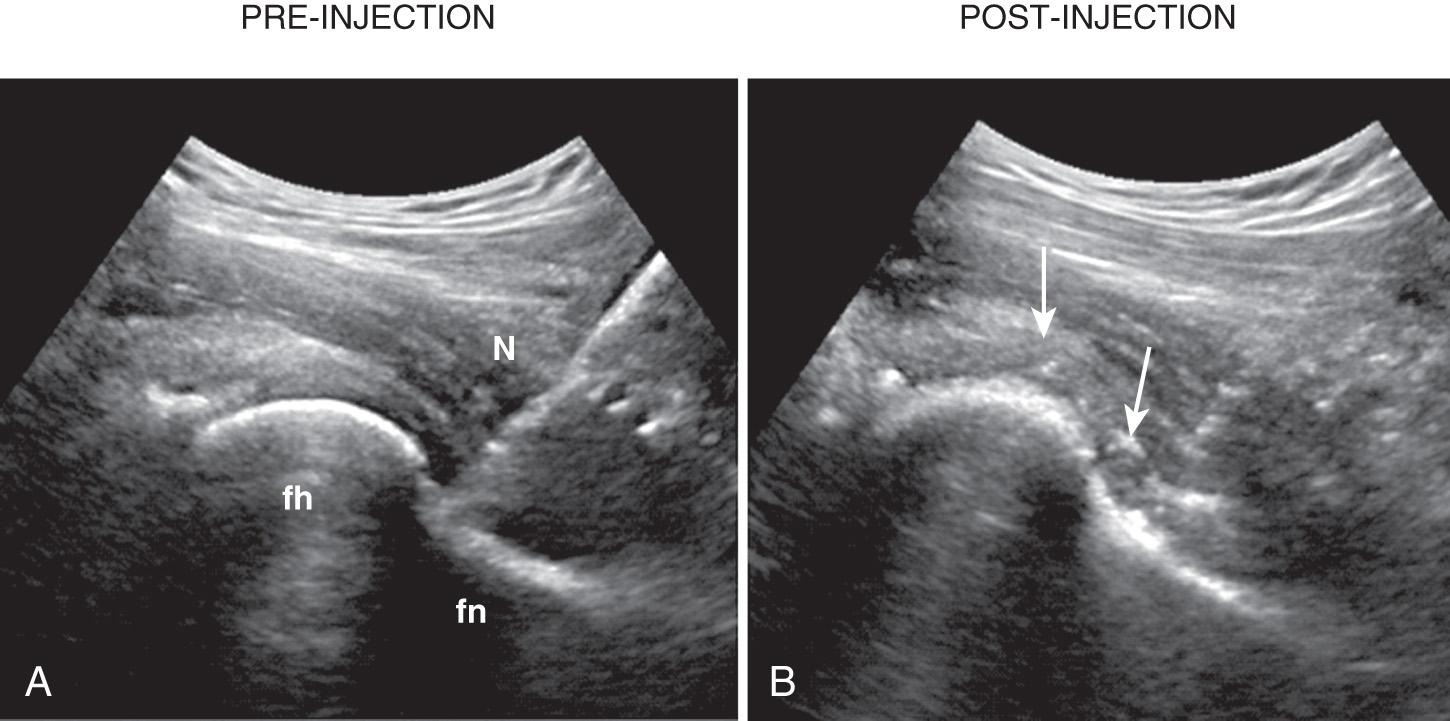
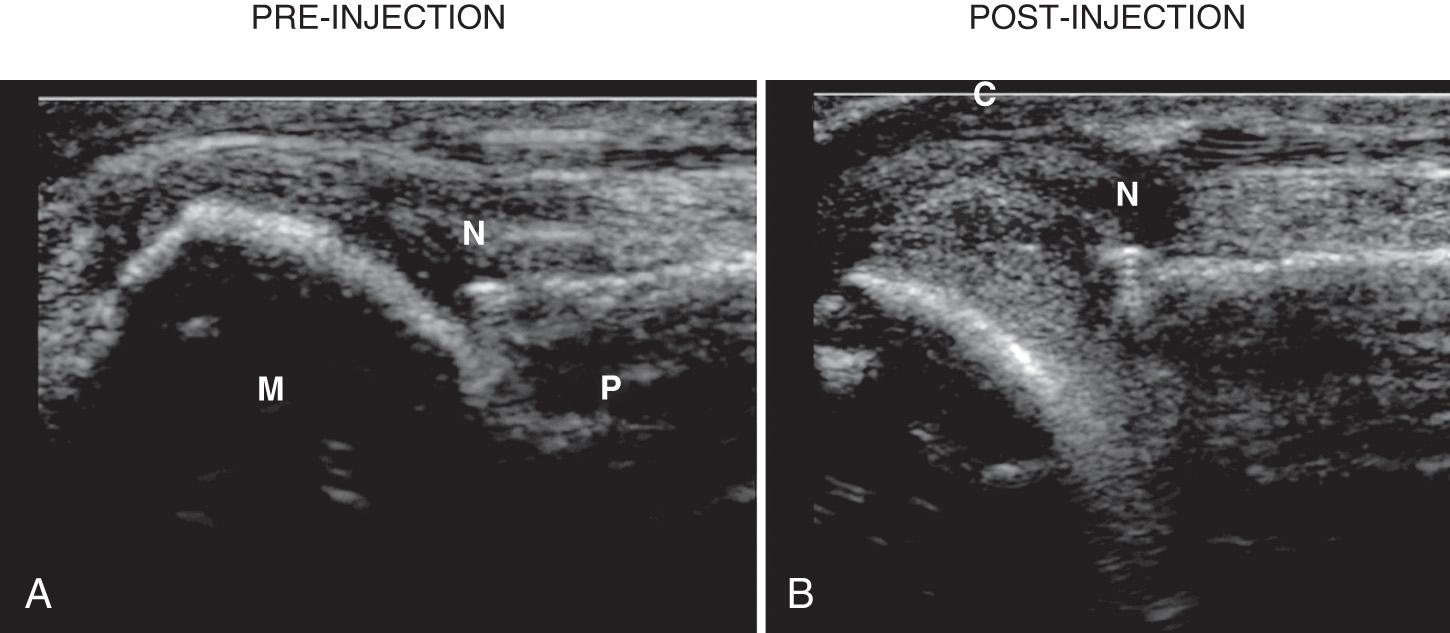
Most injections involve use of a long-acting corticosteroid in combination with a local anesthetic in relatively small volumes. Injectable steroids usually come in either a crystalline form, associated with a slower rate of absorption, or a soluble form, characterized by rapid absorption. Crystalline agents include triamcinolone and methylprednisolone acetate (Depo-Medrol). A common soluble agent is Celestone, which includes a rapidly absorbed betamethasone salt. A reactive inflammatory response or flushing response may occur with crystalline steroids, but typically not with soluble agents.
The most significant complications associated with injectable steroid use in the musculoskeletal system relate to chondrolysis (when used in weight-bearing joints), depigmentation, fat necrosis, and impaired healing response (when used in soft tissues). Impaired healing has been associated with tendon, ligament, and plantar fascia rupture. The most frequently used mixtures contain insoluble particles, so a systemic injection could theoretically result in an “embolic phenomenon,” which has been implicated as a mechanism for neurologic complications associated with transforaminal epidural injections. We have not encountered this as a complication when performing injections in the appendicular skeletal system.
The most common anesthetics are lidocaine (Xylocaine) and bupivacaine (Marcaine). Both are characterized as “local injectable anesthetics” but differ in the onset of effect and duration. Lidocaine is characterized by early onset (seconds) and short duration (1-2 hours). Bupivacaine becomes effective in 5 to 10 minutes, and its effects generally last 4 to 6 hours. In addition to allergic reactions, potential adverse effects include neurotoxicity and cardiotoxicity; these are generally rare when small doses are used under image guidance, taking care to avoid an intravascular injection. Bupivacaine has also been associated with chondrolysis when used for intraarticular applications, but only with constant infusions during arthroscopy and in vitro . Chondrolysis is probably not an issue with the small, fixed volumes of bupivacaine typically used during injections in the musculoskeletal system.
A high-frequency linear transducer is used for hand, wrist, elbow, foot, and ankle injections. A short-axis approach is often technically easier for small joint injections. The needle should enter the skin parallel to the plane of the joint space. Superficial joints usually appear as separations between the normally continuous specular echoes produced by cortical surfaces. As in other fluid-containing structures, the presence of an effusion is a helpful feature in visualizing the needle as it enters the joint, because it provides a fluid standoff.
The short-axis approach entails scanning across the joint and looking for the transition from one cortical surface to the next, marking the skin (with a surgical marker), and then placing a needle into the joint using ultrasound guidance. When imaging the joint in long axis, the needle will be seen in cross section ( Fig. 25.5 ). Needle placement is confirmed by injecting a small amount of 1% lidocaine, which should display distention of the joint, as well as echoes filling the joint. Small joint injections generally require 0.5 to 1 mL of the therapeutic mixture. In my experience, this approach works well in the metatarsophalangeal (MTP) or metacarpophalangeal (MCP) and interphalangeal (IP) joints, midfoot, ankle, and elbow. Occasionally a long-axis approach may be efficacious, as in the radiocarpal joint or lateral gutter of the ankle. Ultrasound guidance allows the clinician to negotiate osteophytes and joint bodies. It allows identification of capsular outpouching, thereby affording a more convenient, indirect approach into a joint than slipping a needle into a small joint space.
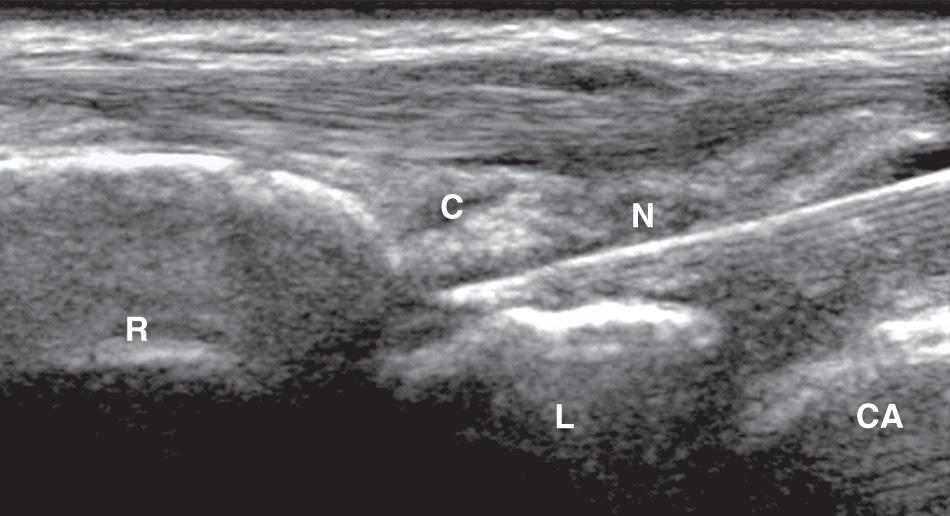
A long-axis approach and a spinal needle are used when performing injections of large joints such as the hip or shoulder ( Fig. 25.6 ). A greater volume is usually injected, typically 5 mL of the steroid-anesthetic mixture. In the case of adhesive capsulitis, significantly larger volumes of local anesthetic (5-10 mL) may be added to provide additional joint distention. We generally approach the glenohumeral joint using a posterior approach, with the patient in a decubitus position and the arm placed in cross-adduction. An intermediate-frequency, linear or curvilinear transducer will suffice in most cases. A linear transducer often results in better anatomic detail than curved arrays. The interface of the glenohumeral joint is usually seen with the patient in the decubitus position, as well as the hypoechoic articular cartilage overlying the humeral head. We perform this injection using a long-axis approach, with the needle directed toward the joint along the articular cartilage and deep to the posterior capsule. A test injection with 1% lidocaine should show bright echoes filling the posterior recess or distributed along the articular cartilage.
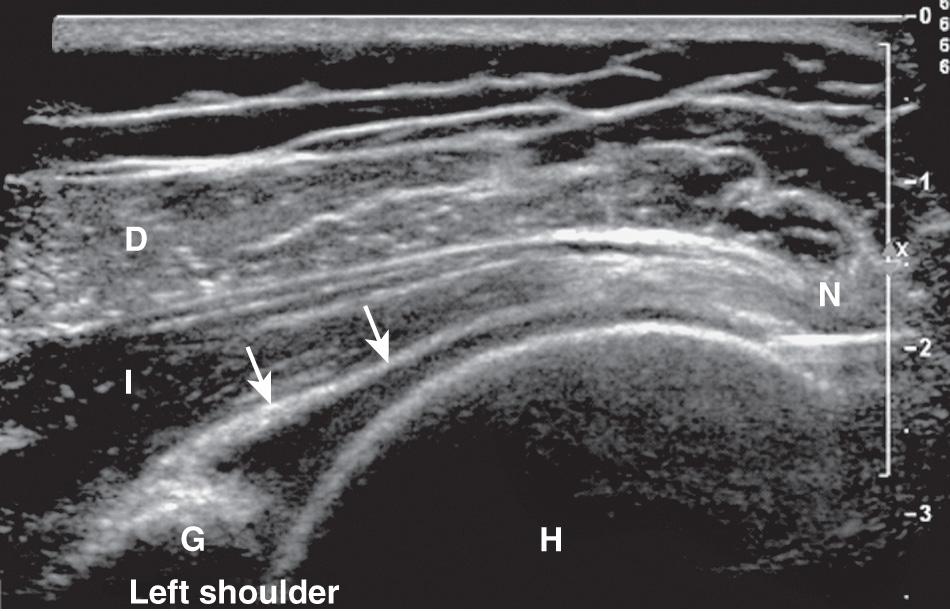
The hip is approached similarly in long axis, with the transducer placed over the proximal anterior thigh at the level of the joint (see Fig. 25.3 , ). The approach is similar to that used in evaluating the joint for an effusion. Ideally, the anterior capsule is imaged at the head-neck junction of the femur. In this approach the scan plane is lateral to the neurovascular bundle. The needle may be directed into the joint while maintaining its position in the scan plane of the transducer. A test injection of 1% lidocaine confirms the intraarticular needle position, and the therapeutic injection follows.
Fibrous joints, such as the acromioclavicular (AC) joint, can likewise be injected using ultrasound guidance ( Fig. 25.7 ). A short-axis technique is employed similar to that used in the foot. The majority of these injections can be performed using a 1.5-inch needle with a small volume (0.5-1.0 mL) of therapeutic mixture. In addition to the AC joint, this approach is useful in the sternoclavicular joint and pubic symphysis.
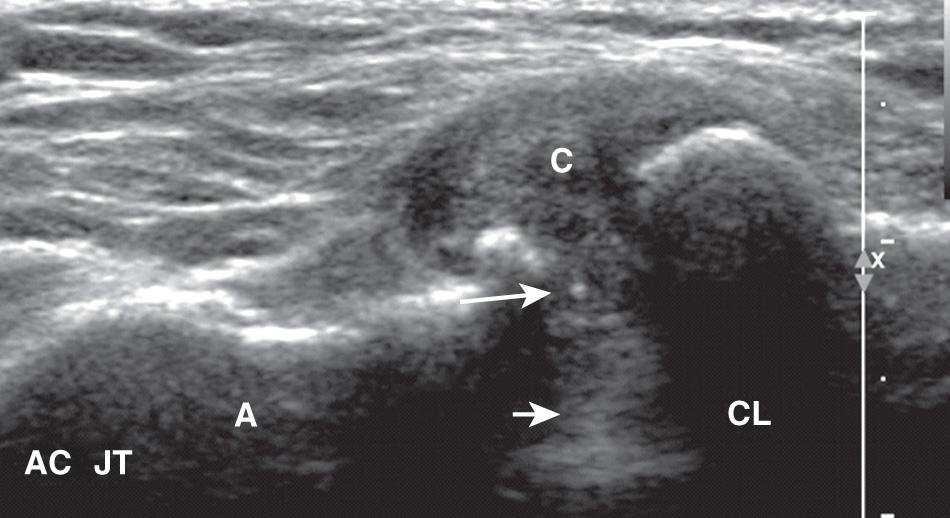
Become a Clinical Tree membership for Full access and enjoy Unlimited articles
If you are a member. Log in here